Improving the Degree of Surface Isotropy of Parts Manufactured Using Hybrid Machining Processes
Abstract
1. Introduction
2. Methodology for Testing Changes in the Degree of Surface Isotropy
2.1. Sample Preparation
2.2. Surface Geometrical Texture Measurements
3. Results and Discussion
4. Conclusions
- The use of SI parameters to describe the efficiency of machining avoids subjective evaluation of the produced surface by the technologist. In addition, the criterion of isotropy, combined with the values of the height parameters of the SGT, allows a more efficient selection of technological processing parameters of often different machining operations combined into a single HMP.
- As the surface roughness decreases after milling, the marks left by the burnishing process become increasingly visible. This means that in the case of two-pass burnishing, in addition to the first direction of milling, there are often second and third directions of the marks left on the surface by the burnishing tool. This, in turn, prevents the transition from an anisotropic milled surface to an isotropic burnished surface, for which the degree of SI would be higher than 80%.
- Burnishing strategies using two machining passes are characterised by a smaller degree of SI scatter compared to machining with one burnishing pass. This is due to the mechanics of the process and the lesser influence of the so-called machining after the mark left by the earlier machining.
- In the course of the study, the DC strategy with two crossed burnishing passes oriented obliquely to the marks left by the cutter proved to be the most favourable of the burnishing strategies tested. Comparably good results can be achieved with an orthogonal strategy with a single burnishing pass (SC type). In this case, a prerequisite for success is the use of a low value of the line feed rate during burnishing. The weakest performance during the tests was with a double orthogonal strategy (DO type), in which two burnishing passes were made perpendicular to the cutter marks.
- During the burnishing process, a low burnishing force of Fb = 1000 N was used, sufficient to reduce the high-amplitude components of surface roughness. Unfortunately, for the compensation of low-amplitude and long-period roughness components, tools with burnishing balls (rollers) must be used that significantly exceed the radii of the cutting inserts used in milling, in which case the burnishing must be carried out at a much higher value of the force Fb.
- A radical improvement in the degree of SI, i.e., an increase of more than 80%, could be achieved by using tools in which, in addition to the basic feed movement of the burnishing, there would be an additional rotational movement of the burnishing head (equipped with a greater number of burnishing balls or rollers).
- There is a high probability that the produced anisotropic SGT (e.g., of a stamping die or a die) will be transferred to the surface of the manufactured products, causing them to tarnish. Also, the quality of the protective coatings applied or the quality of lubrication of the product surfaces will depend on the dominant direction of the marks left by tools during milling.
Author Contributions
Funding
Institutional Review Board Statement
Informed Consent Statement
Data Availability Statement
Conflicts of Interest
Abbreviations
| BSV | Burnished surface variant |
| CNC | Computer Numerical Control |
| DC | Double cross burnishing strategy |
| DO | Double orthogonal burnishing strategy |
| HMP | Hybrid machining process |
| HRC | Rockwell hardness of hardened steel |
| SC | Single cross burnishing strategy |
| SGT | Surface geometrical texture |
| SI | Surface isotropy |
Appendix A. Surface Isotropy


- Sal—Surface autocorrelation length;
- Str—Surface texture aspect ratio;
- Std—Surface texture directionality.
References
- Thomas, T.R. Rough Surfaces, 2nd ed.; World Scientific Publishing Company: Singapore, 1998. [Google Scholar]
- Smith, G.T. Industrial Metrology, Surfaces and Roundness; Springer: London, UK, 2002. [Google Scholar]
- Muralikrishnan, B.; Raja, J. Computational Surface and Roundness Metrology; Springer: London, UK, 2009. [Google Scholar]
- Nozdrzykowski, K.; Grządziel, Z.; Dunaj, P. Analysis of contact deformations in support systems using roller prisms. Materials 2021, 14, 2644. [Google Scholar] [CrossRef] [PubMed]
- Ryba, T.; Rucki, M.; Siemiatkowski, Z.; Bzinkowski, D.; Solecki, M. Design and calibration of the system supervising belt tension and wear in an industrial feeder. Facta Univ. 2022, 20, 167–176. [Google Scholar] [CrossRef]
- Sługocka, M.; Grochała, D.; Kwiatkowski, K.; Grzejda, R.; Zmarzły, P. Study of the impact of surface topography on selected mechanical properties of adhesive joints. Coatings 2024, 14, 944. [Google Scholar] [CrossRef]
- Grochała, D.; Jasiewicz, M.; Filipowicz, K.; Parus, A.; Powałka, B.; Grzejda, R.; Zmarzły, P. Assessment of the functional properties of the surfaces of ductile cast iron parts. Appl. Sci. 2024, 14, 9129. [Google Scholar] [CrossRef]
- Gdula, M.; Józwik, J.; Skoczylas, A. Tool wear and surface topography shaping after TPl multi-axis milling of Ni-based superalloy of the torus milling cutter using the strategy of adaptive change of the active cutting edge segment. Wear 2025, 562–563, 205637. [Google Scholar] [CrossRef]
- Grudzień, J.; Grochała, D.; Grzejda, R.; Kochmański, P. Testing the effectiveness of hybrid milling and surface burnishing in improving the wear resistance of machine parts made of structural steel. Lubricants 2024, 12, 458. [Google Scholar] [CrossRef]
- Zhu, Z.; Dhokia, V.G.; Nassehi, A.; Newman, S.T. A review of hybrid manufacturing processes—State of the art and future perspectives. Int. J. Comput. Integr. Manuf. 2013, 26, 596–615. [Google Scholar] [CrossRef]
- Chu, W.-S.; Kim, C.-S.; Lee, H.-T.; Choi, J.-O.; Park, J.-I.; Song, J.-H.; Jang, K.-H.; Ahn, S.-H. Hybrid manufacturing in micro/nano scale: A Review. Int. J. Precis. Eng. Manuf.-Green Technol. 2014, 1, 75–92. [Google Scholar] [CrossRef]
- Schuh, G.; Kreysa, J.; Orilski, S. Roadmap “Hybrid production”. Z. Wirtsch. Fabrikbetr. 2009, 104, 385–391. (In Germany) [Google Scholar] [CrossRef]
- Lauwers, B.; Klocke, F.; Klink, A.; Tekkaya, A.E.; Neugebauer, R.; Mcintosh, D. Hybrid processes in manufacturing. CIRP Ann. 2014, 63, 561–583. [Google Scholar] [CrossRef]
- Nau, B.; Roderburg, A.; Klocke, F. Ramp-up of hybrid manufacturing technologies. CIRP J. Manuf. Sci. Technol. 2011, 4, 313–316. [Google Scholar] [CrossRef]
- Klocke, F.; Stauder, J.; Mattfeld, P.; Müller, J. Modeling of manufacturing technologies during ramp-up. Procedia CIRP 2016, 51, 122–127. [Google Scholar] [CrossRef][Green Version]
- Lauwers, B.; Klocke, F.; Klink, A. Advanced Manufacturing Through the Implementation of Hybrid and Media Assisted Processes. In Proceedings of the International Chemnitz Manufacturing Colloquium, Chemnitz, Germany, 29–30 September 2010; pp. 205–220. [Google Scholar]
- Rajurkar, K.P.; Zhu, D.; McGeough, J.A.; Kozak, J.; De Silva, A. New developments in electro-chemical machining. CIRP Ann. 1999, 48, 567–579. [Google Scholar] [CrossRef]
- Dandekar, C.R.; Shin, Y.C.; Barnes, J. Machinability improvement of titanium alloy (Ti-6Al-4V) via LAM and hybrid machining. Int. J. Mach. Tools Manuf. 2010, 50, 174–182. [Google Scholar] [CrossRef]
- Swirad, S.; Wdowik, R. Determining the effect of ball burnishing parameters on surface roughness using the Taguchi method. Procedia Manuf. 2019, 34, 287–292. [Google Scholar] [CrossRef]
- López de Lacalle, L.N.; Rodríguez, A.; Lamikiz, A.; Celaya, A.; Alberdi, R. Five-axis machining and burnishing of complex parts for the improvement of surface roughness. Mater. Manuf. Process. 2011, 26, 997–1003. [Google Scholar] [CrossRef]
- Kalisz, J.; Żak, K.; Wojciechowski, S.; Gupta, M.K.; Krolczyk, G.M. Technological and tribological aspects of milling-burnishing process of complex surfaces. Tribol. Int. 2021, 155, 106770. [Google Scholar] [CrossRef]
- Teimouri, R.; Grabowski, M.; Kowalczyk, M.; Skoczypiec, S. Simulation of surface roughness alternation in milling-burnishing sequence. Measurement 2023, 218, 113160. [Google Scholar] [CrossRef]
- Mezlini, S.; Mzali, S.; Sghaier, S.; Braham, C.; Kapsa, P. Effect of a combined machining/burnishing tool on the roughness and mechanical properties. Lubr. Sci. 2014, 26, 175–187. [Google Scholar] [CrossRef]
- Boozarpoor, M.; Elyasi, M.; Hosseinzadeh, M. An investigation of the surface quality of burnished AISI 4340 steel. Proc. Inst. Mech. Eng. Part E J. Process Mech. Eng. 2018, 232, 299–313. [Google Scholar] [CrossRef]
- Arsalani, M.; Razfar, M.R.; Abdullah, A.; Khajehzadeh, M. Fatigue behavior improvement of hardened parts using sequential hard turning, grinding, and ball burnishing operations. Proc. Inst. Mech. Eng. Part L J. Mater. Des. Appl. 2021, 235, 87–99. [Google Scholar] [CrossRef]
- Dyl, T.; Rydz, D.; Szarek, A.; Stradomski, G.; Fik, J.; Opydo, M. The influence of slide burnishing on the technological quality of X2CrNiMo17-12-2 steel. Materials 2024, 17, 3403. [Google Scholar] [CrossRef] [PubMed]
- Nadolny, K.; Plichta, J.; Radowski, M. Reciprocal internal cylindrical grinding integrated with dynamic centrifugal burnishing of hard-to-cut materials. Proc. Inst. Mech. Eng. Part E J. Process Mech. Eng. 2015, 229, 265–279. [Google Scholar] [CrossRef]
- Teimouri, R.; Amini, S.; Bami, A.B. Evaluation of optimized surface properties and residual stress in ultrasonic assisted ball burnishing of AA6061-T6. Measurement 2018, 116, 129–139. [Google Scholar] [CrossRef]
- Amini, S.; Bagheri, A.; Teimouri, R. Ultrasonic assisted ball burnishing of aluminum 6061 and AISI 1045 steel. Mater. Manuf. Process. 2018, 33, 1250–1259. [Google Scholar] [CrossRef]
- Khosrojerdi, M.; Razfar, M.R.; Fesharakifard, R.; Khajehzadeh, M. Improvement of the frictional behavior of Al 7075-T6 by ultrasonic-assisted ball burnishing process. Proc. Inst. Mech. Eng. Part L J. Mater. Des. Appl. 2023, 237, 1082–1092. [Google Scholar] [CrossRef]
- Ghodake, A.P.; Rakhade, R.D.; Maheshwari, A.S. Effect of burnishing process on behavior of engineering materials—A review. IOSR J. Mech. Civ. Eng. 2013, 5, 9–20. [Google Scholar]
- Bachtiak-Radka, E.; Grochała, D.; Chmielewski, K.; Olszak, W. The isotropy tests of a milled and hard-burnished surface of the X160CrMoV121 steel. Mechanik 2015, 88, 641–653. [Google Scholar] [CrossRef][Green Version]
- Świrad, S.; Wydrzynski, D.; Nieslony, P.; Krolczyk, G.M. Influence of hydrostatic burnishing strategy on the surface topography of martensitic steel. Measurement 2019, 138, 590–601. [Google Scholar] [CrossRef]
- Qi, B.; Chai, Z.; Huang, X.; Guo, W.; Ren, X.; Chen, H.; Chen, X. Surface integrity improvement of the ground surface of Inconel 718 fabricated by forging and additive manufacturing using a robotic rotational burnishing method. J. Manuf. Process. 2024, 125, 566–579. [Google Scholar] [CrossRef]
- Zhou, Z.; Shi, H.; Zheng, Q.; Li, Y.; Jiang, Z.; Yuan, Z.; Piao, Z. Research on fabricating gradient nanostructure and enhancing wear resistance in aluminum alloy via two-dimensional ultrasonic surface burnishing. Surf. Coat. Technol. 2024, 494, 131302. [Google Scholar]
- Keymanesh, M.; Ji, H.; Zhang, X.; Wang, J.; Feng, P.; Zhang, J. Multi-roller taper burnishing of internal chamfers and its enhancement mechanism on 7050 aluminum alloy. Int. J. Fatigue 2024, 189, 108571. [Google Scholar] [CrossRef]
- El-Taweel, T.A.; El-Axir, M.H. Analysis and optimization of the ball burnishing process through the Taguchi technique. Int. J. Adv. Manuf. Technol. 2009, 41, 301–310. [Google Scholar] [CrossRef]
- Gharbi, F.; Sghaier, S.; Al-Fadhalah, K.J.; Benameur, T. Effect of ball burnishing process on the surface quality and microstructure properties of AISI 1010 steel plates. J. Mater. Eng. Perform. 2011, 20, 903–910. [Google Scholar] [CrossRef]
- Korzynski, M.; Pacana, A.; Cwanek, J. Fatigue strength of chromium coated elements and possibility of its improvement with slide diamond burnishing. Surf. Coat. Technol. 2009, 203, 1670–1676. [Google Scholar] [CrossRef]
- Avilés, R.; Albizuri, J.; Rodríguez, A.; López de Lacalle, L.N. Influence of low-plasticity ball burnishing on the high-cycle fatigue strength of medium carbon AISI 1045 steel. Int. J. Fatigue 2013, 55, 230–244. [Google Scholar] [CrossRef]
- Travieso-Rodriguez, J.A.; Gómez Gras, G.; Jorba Peiró, J.; Carrillo, F.; Dessein, G.; Alexis, J.; González Rojas, H. Experimental study on the mechanical effects of the vibration-assisted ball-burnishing process. Mater. Manuf. Process. 2015, 30, 1490–1497. [Google Scholar] [CrossRef]
- Travieso-Rodriguez, J.A.; Gomez-Gras, G.; Dessein, G.; Carrillo, F.; Alexis, J.; Jorba Peiró, J.; Aubazac, N. Effects of a ball-burnishing process assisted by vibrations in G10380 steel specimens. Int. J. Adv. Manuf. Technol. 2015, 81, 1757–1765. [Google Scholar] [CrossRef]
- Revankar, G.D.; Shetty, R.; Rao, S.S.; Gaitonde, V.N. Analysis of surface roughness and hardness in ball burnishing of titanium alloy. Measurement 2014, 58, 256–268. [Google Scholar] [CrossRef]
- Revankar, G.D.; Shetty, R.; Rao, S.S.; Gaitonde, V.N. Wear resistance enhancement of titanium alloy (Ti–6Al–4V) by ball burnishing process. J. Mater. Res. Technol. 2017, 6, 13–32. [Google Scholar] [CrossRef]
- Luo, H.; Liu, J.; Wang, L.; Zhong, Q. Study of the mechanism of the burnishing process with cylindrical polycrystalline diamond tools. J. Mater. Process. Technol. 2006, 180, 9–16. [Google Scholar] [CrossRef]
- Hiegemann, L.; Weddeling, C.; Khalifa, N.B.; Tekkaya, A.E. Analytical prediction of roughness after ball burnishing of thermally coated surfaces. Procedia Eng. 2014, 81, 1921–1926. [Google Scholar] [CrossRef]
- Hiegemann, L.; Weddeling, C.; Khalifa, N.B.; Tekkaya, A.E. Prediction of roughness after ball burnishing of thermally coated surfaces. J. Mater. Process. Technol. 2015, 217, 193–201. [Google Scholar] [CrossRef]
- Korzynski, M. Modeling and experimental validation of the force–surface roughness relation for smoothing burnishing with a spherical tool. Int. J. Mach. Tools Manuf. 2007, 47, 1956–1964. [Google Scholar] [CrossRef]
- Grochała, D.; Berczyński, S.; Grządziel, Z. Stress in the surface layer of objects burnished after milling. Int. J. Adv. Manuf. Technol. 2014, 72, 1655–1663. [Google Scholar] [CrossRef]
- López de Lacalle, L.N.; Lamikiz, A.; Muñoa, J.; Sánchez, J.A. Quality improvement of ball-end milled sculptured surfaces by ball burnishing. Int. J. Mach. Tools Manuf. 2005, 45, 1659–1668. [Google Scholar] [CrossRef]
- Rodríguez, A.; López de Lacalle, L.N.; Celaya, A.; Lamikiz, A.; Albizuri, J. Surface improvement of shafts by the deep ball-burnishing technique. Surf. Coat. Technol. 2012, 206, 2817–2824. [Google Scholar] [CrossRef]
- Olszak, W.; Grochała, D.; Koza, K. Tool for Surface Burnishing. PAT.220528, 5 March 2015. [Google Scholar]
- Posdzich, M.; Stöckmann, R.; Witt, M.; Putz, M. Determination of surface shape deviation by using force-controlled burnishing. Procedia CIRP 2020, 93, 1275–1280. [Google Scholar] [CrossRef]
- Winogrodzka, A.; Valefi, M.; de Rooij, M.B.; Schipper, D.J. Measurement of chemical and geometrical surface changes in a wear track by a confocal height sensor and confocal Raman spectroscopy. Arch. Civ. Mech. Eng. 2014, 14, 1–5. [Google Scholar] [CrossRef]
- Liang, Y.; Zhang, S. Least-squares versus partial least-squares finite element methods: Robust a priori and a posteriori error estimates of augmented mixed finite element methods. Comput. Math. Appl. 2025, 184, 45–64. [Google Scholar] [CrossRef]
- Zmarzły, P. Influence of bearing raceway surface topography on the level of generated vibration as an example of operational heredity. Indian J. Eng. Mater. Sci. 2020, 27, 356–364. [Google Scholar]
- Pawlus, P.; Reizer, R.; Zelasko, W. Prediction of parameters of equivalent sum rough surfaces. Materials 2020, 13, 4898. [Google Scholar] [CrossRef] [PubMed]
- Krajewski, S.J.; Grochała, D.; Tomków, J.; Grzejda, R. Analysis of the surface stereometry of alloyed austenitic steel after fibre laser cutting using confocal microscopy. Coatings 2023, 13, 15. [Google Scholar] [CrossRef]
- Grochała, D.; Grzejda, R.; Parus, A.; Berczyński, S. The wavelet transform for feature extraction and surface roughness evaluation after micromachining. Coatings 2024, 14, 210. [Google Scholar] [CrossRef]
- Podulka, P.; Knapčíková, L.; Tauberová, R.; Martiček, M.; Sukić, E. Study of etched surface topography with the compensation of contactless vibrational measurement errors. Measurement 2025, 242, 116218. [Google Scholar] [CrossRef]
- Podulka, P.; Rudawska, A.; Macek, W. Study of vibrational surface topography measurement errors of LPBF Inconel 718 alloy after shot peening process. Measurement 2025, 243, 116434. [Google Scholar] [CrossRef]
- PN-EN ISO 25178-2; Geometrical Product Specifications (GPS), Surface Texture: Areal, Part 2: Terms, Definitions and Surface Texture Parameters. Polish Committee for Standardization: Warsaw, Poland, 2022.
- Lawrence, K.D.; Shanmugamani, R.; Ramamoorthy, B. Evaluation of image based Abbott–Firestone curve parameters using machine vision for the characterization of cylinder liner surface topography. Measurement 2014, 55, 318–334. [Google Scholar] [CrossRef]
- Kovács, Z.F.; Viharos, Z.J.; Kodácsy, J. Surface flatness and roughness evolution after magnetic assisted ball burnishing of magnetizable and non-magnetizable materials. Measurement 2020, 158, 107750. [Google Scholar] [CrossRef]
- Kovács, Z.F.; Viharos, Z.J.; Kodácsy, J. Improvements of surface tribological properties by magnetic assisted ball burnishing. Surf. Coat. Technol. 2022, 437, 128317. [Google Scholar] [CrossRef]
- López de Lacalle, L.N.; Lamikiz, A.; Sánchez, J.A.; Arana, J.L. The effect of ball burnishing on heat-treated steel and Inconel The effect of ball burnishing on heat-treated steel and Inconel 718 milled surfaces. Int. J. Adv. Manuf. Technol. 2007, 32, 958–968. [Google Scholar] [CrossRef]
- Torres, A.; Amini, C.; Cuadrado, N.; Travieso-Rodriguez, J.A.; Llumà, J.; Vilaseca, M. Experimental validation of ball burnishing numerical simulation on ball-end milled martensitic stainless-steel considering friction and the initial surface topography. J. Mater. Res. Technol. 2023, 22, 3352–3361. [Google Scholar] [CrossRef]
- de Oliveira, D.A.; Martins, A.M.; de Castro Magalhães, F.; Abrão, A.M. Characterization of the topography generated by low plasticity burnishing using advanced techniques. Surf. Coat. Technol. 2022, 448, 128891. [Google Scholar] [CrossRef]
- Bulaha, N. Analysis of Service Properties of Cylindrically Ground Surfaces, Using Standard ISO 25178-2:2012 Surface Texture Parameters. In Proceedings of the 10th International Scientific and Practical Conference, Rēzekne, Latvia, 16–21 June 2015. [Google Scholar]
- Pawlus, P.; Reizer, R.; Wieczorowski, M.; Krolczyk, G.M. Study of surface texture measurement errors. Measurement 2023, 210, 112568. [Google Scholar] [CrossRef]
- Podulka, P.; Macek, W.; Zima, B.; Lesiuk, G.; Branco, R.; Królczyk, G. Roughness evaluation of turned composite surfaces by analysis of the shape of autocorrelation function. Measurement 2023, 222, 113640. [Google Scholar] [CrossRef]
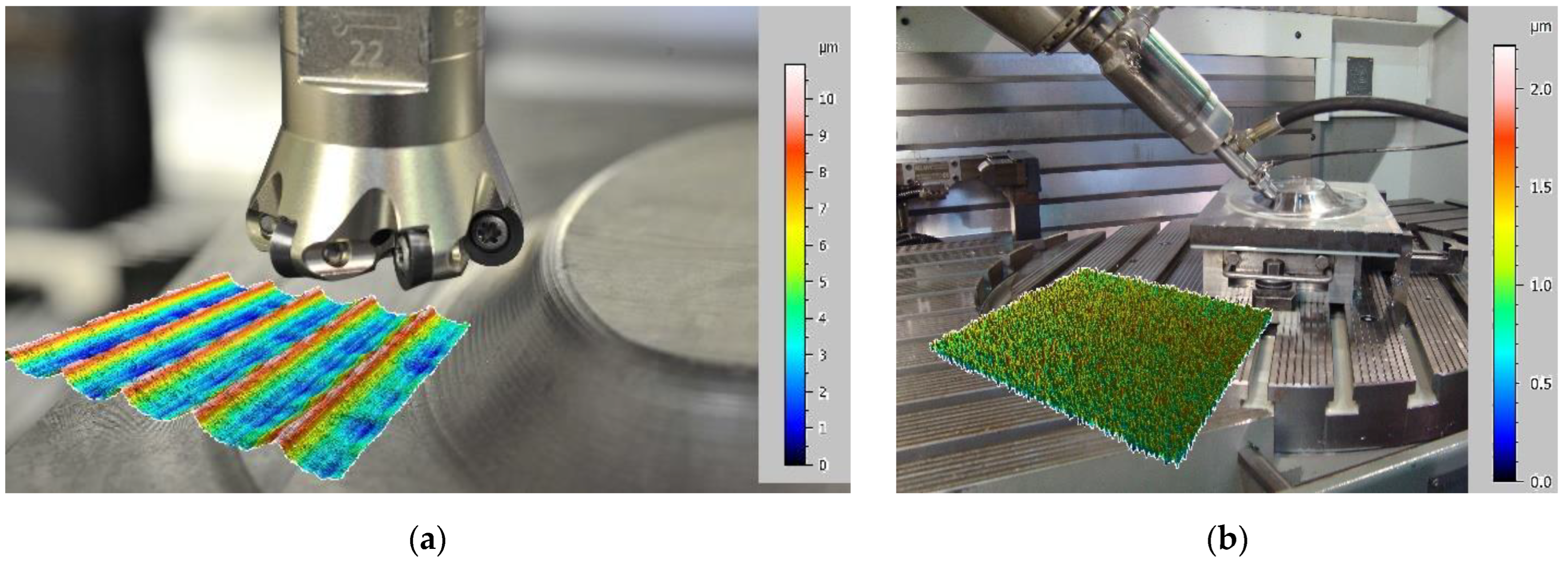


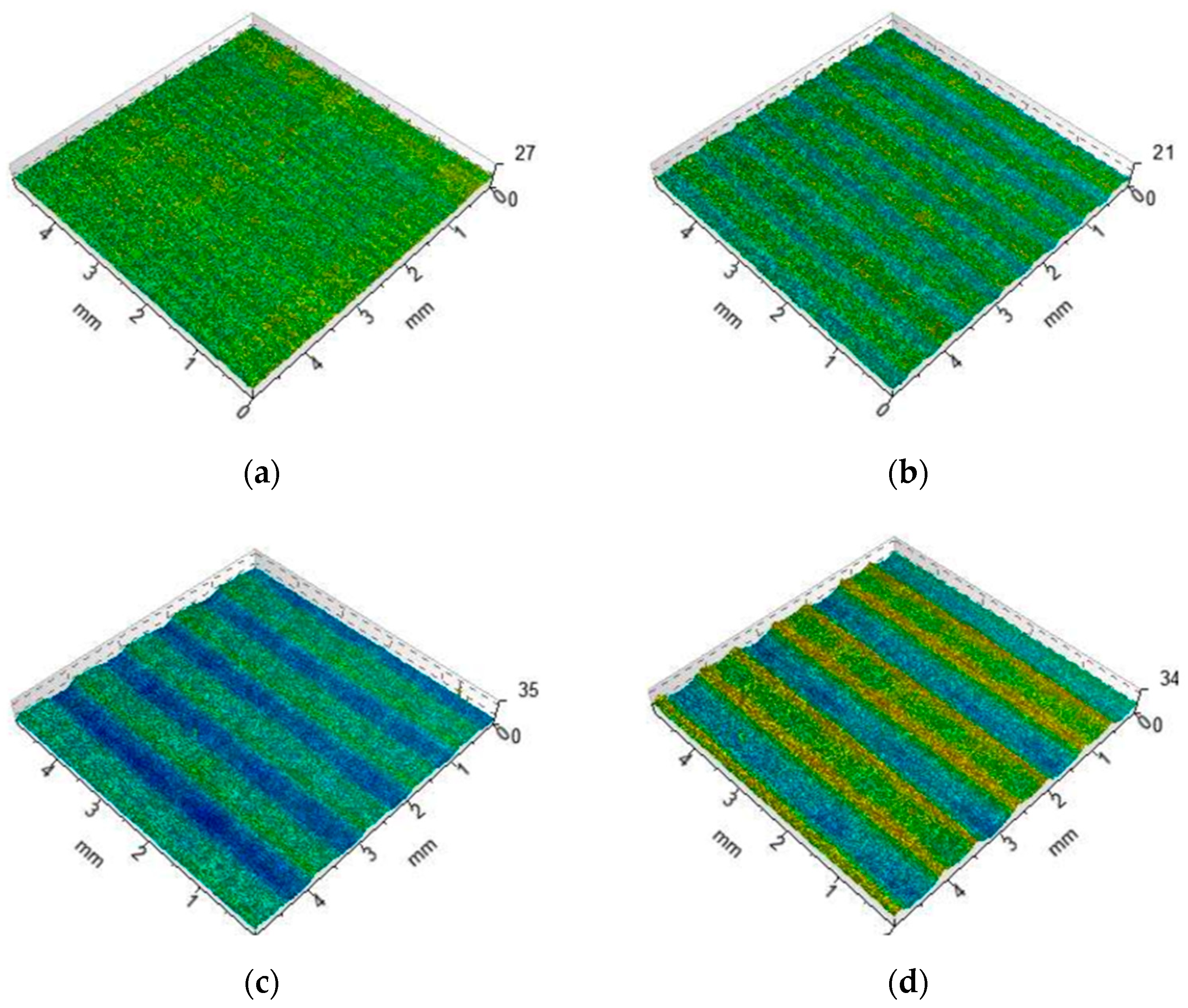
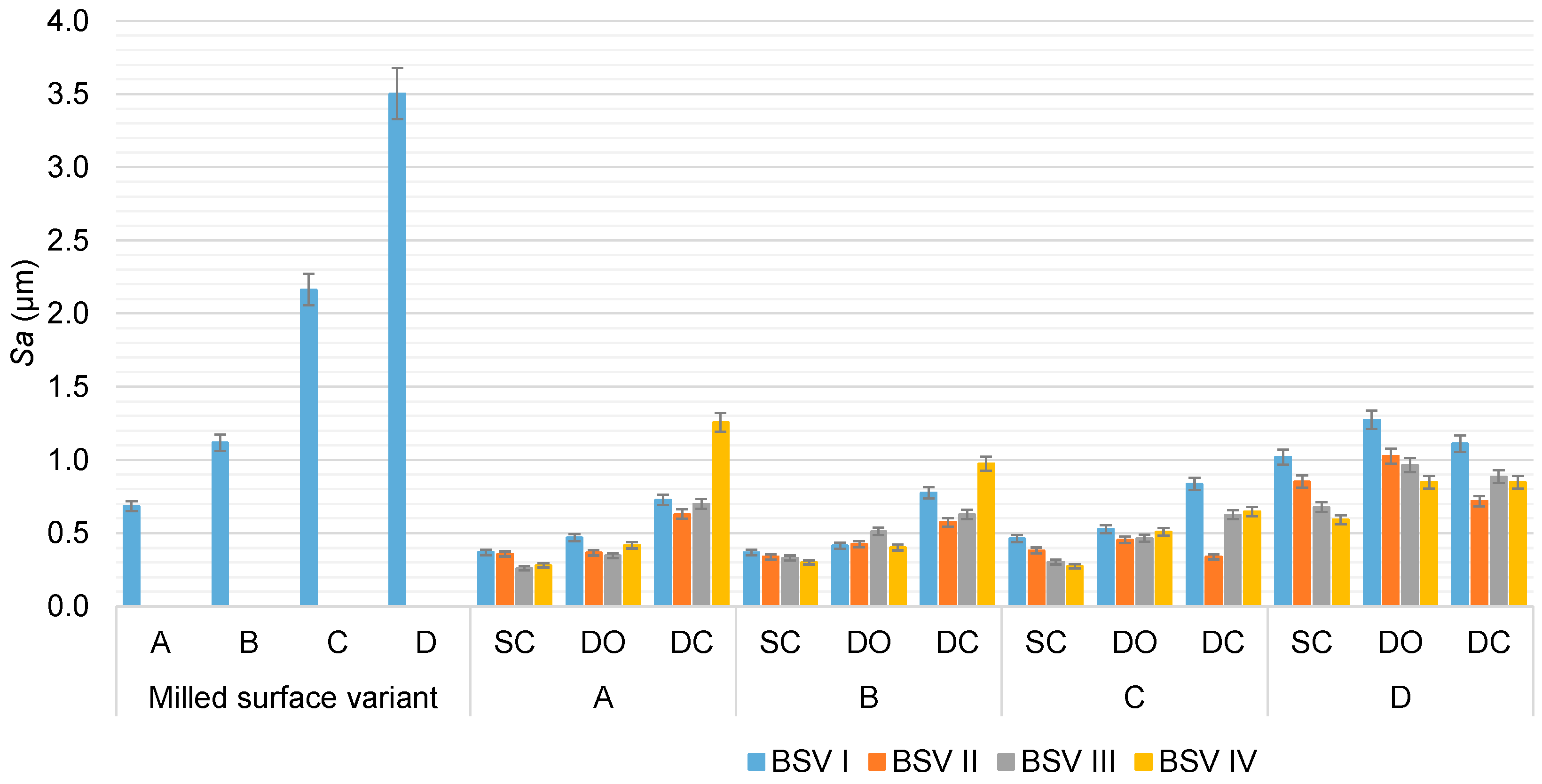
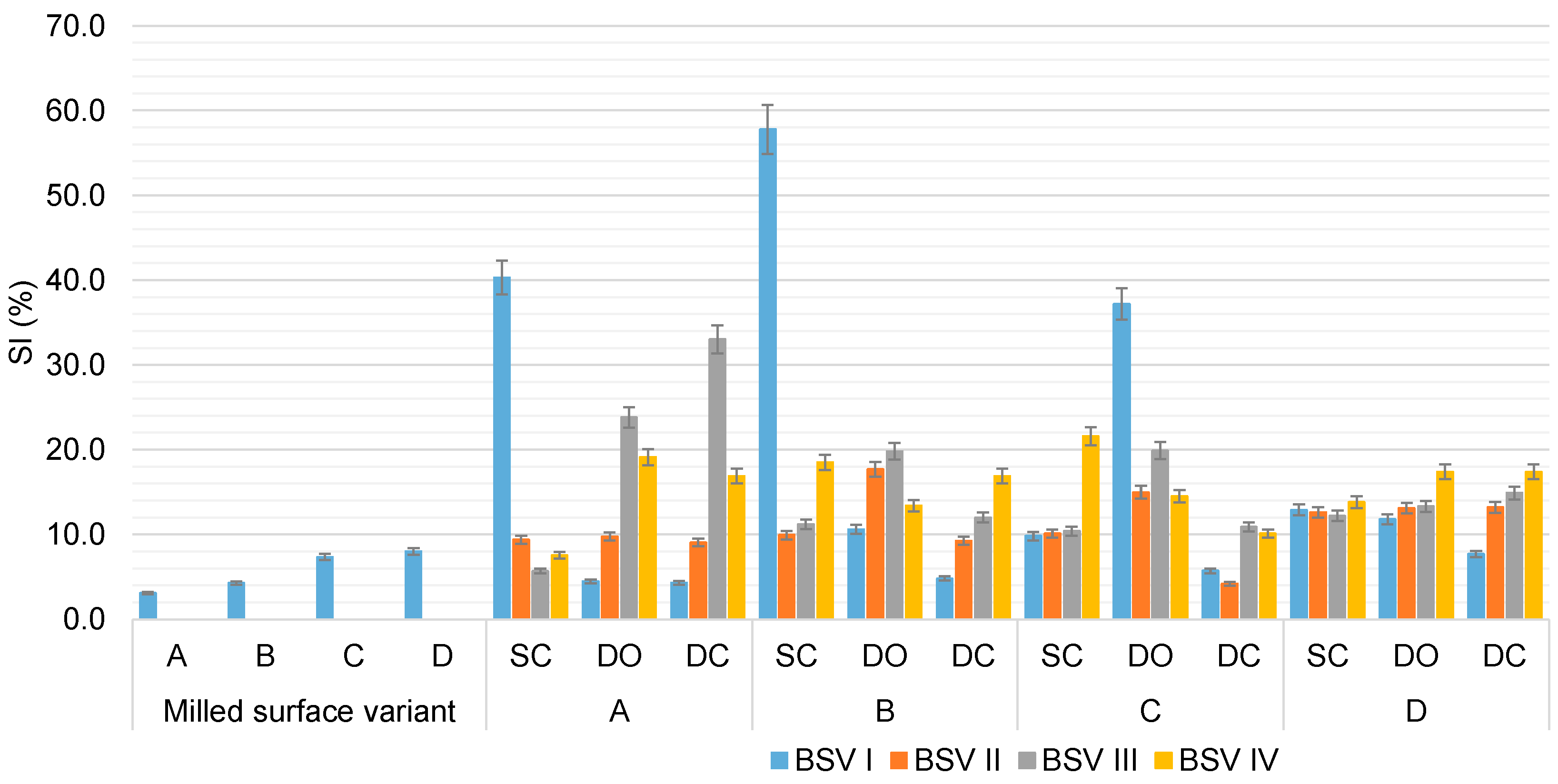
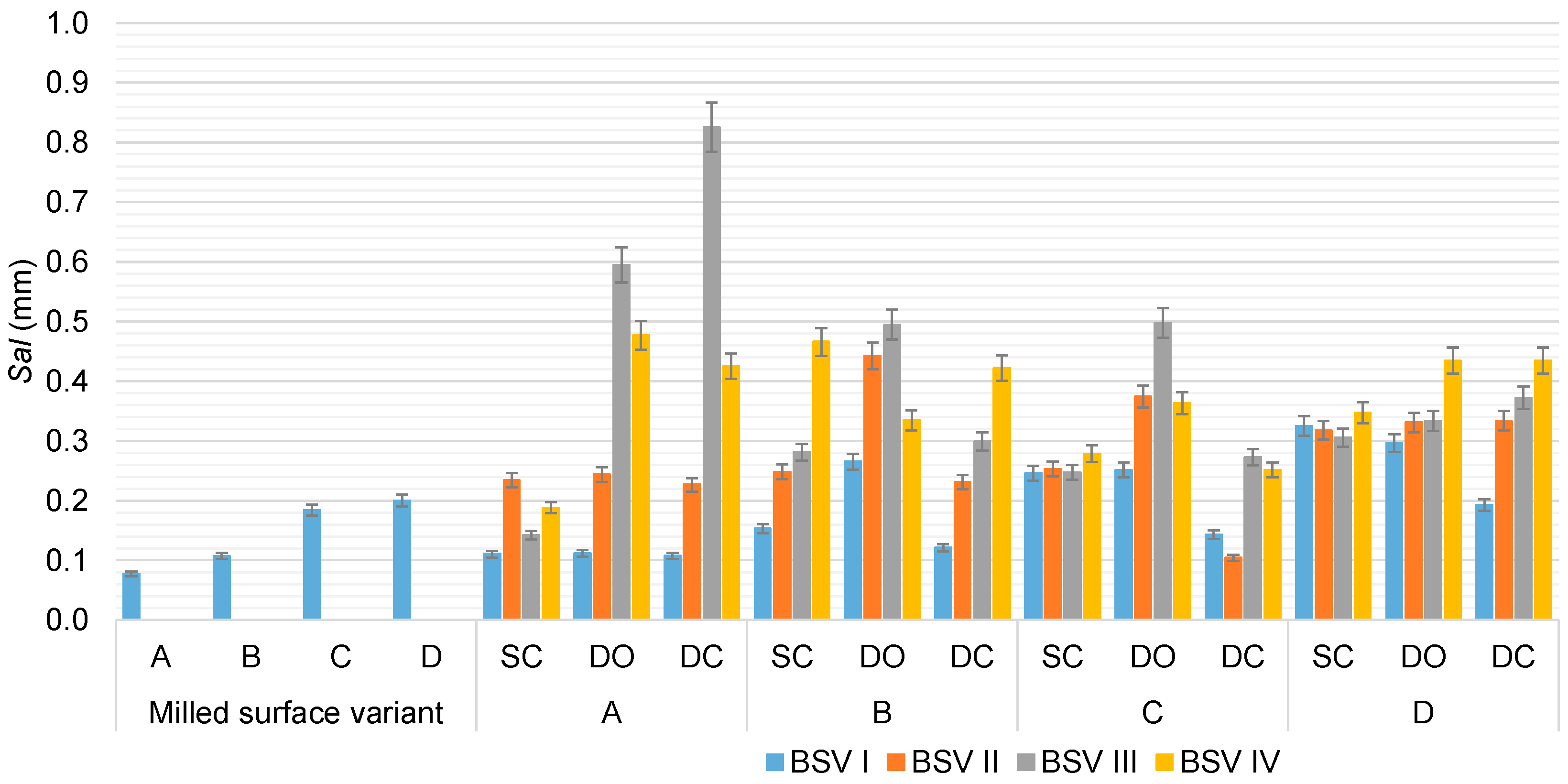
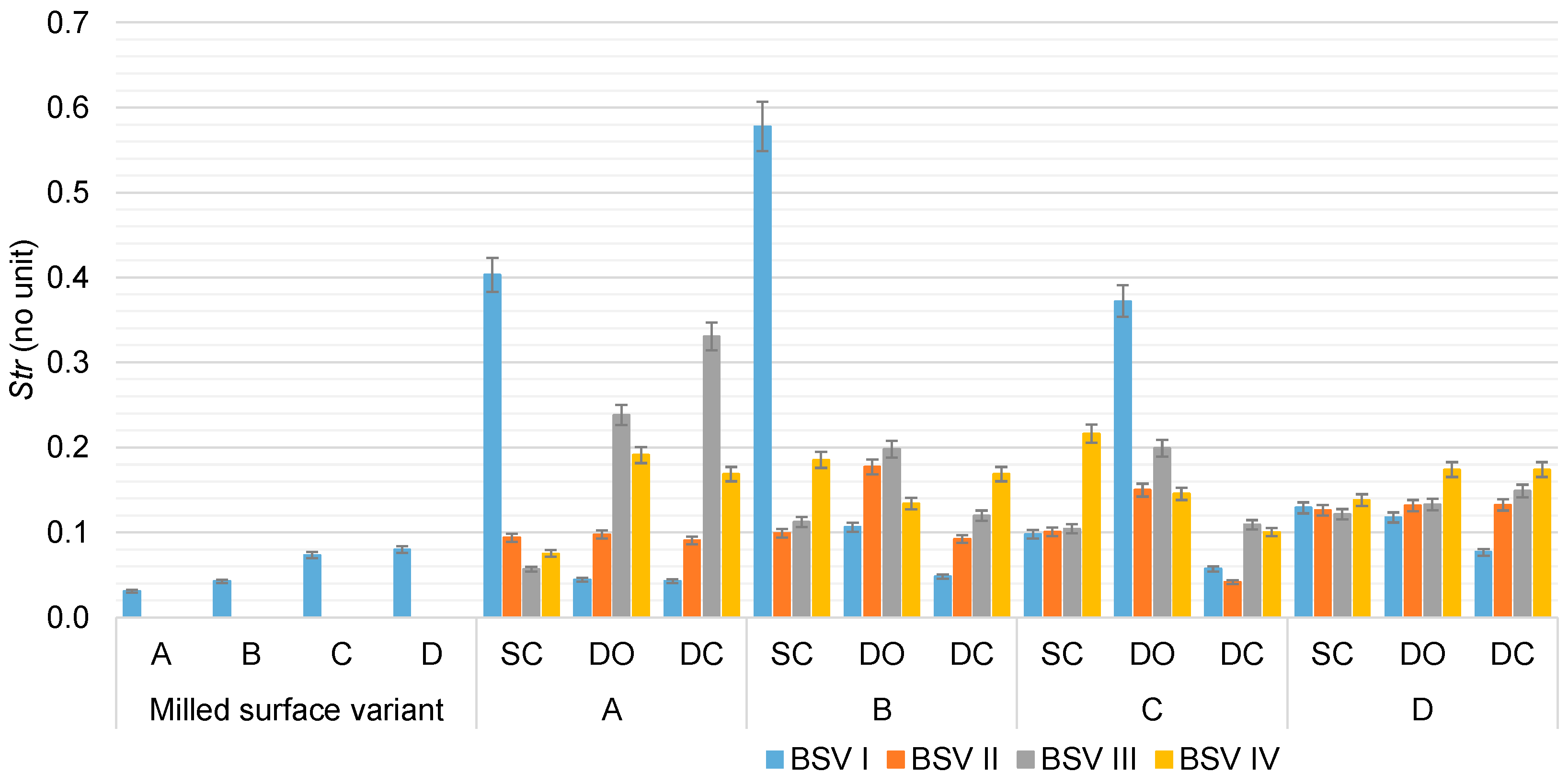




| Strategy | flm 1 (mm) | flb 1 (mm) | ||||||
|---|---|---|---|---|---|---|---|---|
| A | B | C | D | I | II | III | IV | |
| SC | 0.1 | 0.3 | 0.5 | 0.7 | 0.02 | 0.08 | 0.14 | 0.20 |
| DO | 0.1 | 0.3 | 0.5 | 0.7 | 0.02 | 0.08 | 0.14 | 0.20 |
| DC | 0.1 | 0.3 | 0.5 | 0.7 | 0.02 | 0.08 | 0.14 | 0.20 |
| Parameter | Milled Surface Variant | |||
|---|---|---|---|---|
| A | B | C | D | |
| SI (%) | 3.10 | 4.27 | 7.34 | 7.98 |
| Sal (mm) | 0.08 | 0.11 | 0.18 | 0.20 |
| Str (no unit) | 0.03 | 0.04 | 0.07 | 0.08 |
| Std (°) | 89.73 | 89.70 | 89.70 | 89.80 |
| Sa (μm) | 0.68 | 1.12 | 2.16 | 3.50 |
| Sz (μm) | 27.26 | 21.42 | 35.92 | 34.70 |
| Sq (μm) | 0.87 | 1.34 | 2.48 | 4.02 |
| Sp (μm) | 15.36 | 13.24 | 25.31 | 20.36 |
| Sv (μm) | 11.90 | 8.17 | 10.61 | 14.34 |
| Parameter | BSV 1 | Burnishing Strategy | |||||||||||
|---|---|---|---|---|---|---|---|---|---|---|---|---|---|
| SC | DO | DC | |||||||||||
| Milled Surface Variant | |||||||||||||
| A | B | C | D | A | B | C | D | A | B | C | D | ||
| SI (%) | I | 40.3 | 57.8 | 9.81 | 12.9 | 4.47 | 10.6 | 37.2 | 11.8 | 4.27 | 4.83 | 5.71 | 7.69 |
| II | 9.38 | 9.93 | 10.1 | 12.6 | 9.75 | 17.7 | 15.0 | 13.1 | 9.07 | 9.25 | 4.18 | 13.2 | |
| III | 5.68 | 11.2 | 10.4 | 12.2 | 23.8 | 19.8 | 19.9 | 13.3 | 33.0 | 12.0 | 10.9 | 14.9 | |
| IV | 7.53 | 18.5 | 21.6 | 13.8 | 19.1 | 13.4 | 14.5 | 17.4 | 16.9 | 16.9 | 10.1 | 17.4 | |
| Sal (mm) | I | 0.11 | 0.15 | 0.25 | 0.33 | 0.11 | 0.27 | 0.25 | 0.30 | 0.11 | 0.12 | 0.14 | 0.19 |
| II | 0.23 | 0.25 | 0.25 | 0.32 | 0.24 | 0.44 | 0.37 | 0.33 | 0.23 | 0.23 | 0.11 | 0.33 | |
| III | 0.14 | 0.28 | 0.25 | 0.31 | 0.60 | 0.50 | 0.50 | 0.33 | 0.83 | 0.30 | 0.27 | 0.37 | |
| IV | 0.19 | 0.47 | 0.28 | 0.35 | 0.48 | 0.34 | 0.36 | 0.43 | 0.43 | 0.42 | 0.25 | 0.43 | |
| Str (no unit) | I | 0.40 | 0.58 | 0.10 | 0.13 | 0.05 | 0.11 | 0.37 | 0.12 | 0.04 | 0.05 | 0.06 | 0.08 |
| II | 0.09 | 0.10 | 0.10 | 0.13 | 0.10 | 0.18 | 0.15 | 0.13 | 0.09 | 0.09 | 0.04 | 0.13 | |
| III | 0.06 | 0.11 | 0.10 | 0.12 | 0.24 | 0.20 | 0.20 | 0.13 | 0.33 | 0.12 | 0.11 | 0.15 | |
| IV | 0.08 | 0.19 | 0.22 | 0.14 | 0.19 | 0.13 | 0.15 | 0.17 | 0.17 | 0.17 | 0.10 | 0.17 | |
| Std (°) | I | 89.48 | 89.27 | 89.47 | 89.27 | 89.75 | 89.73 | 89.75 | 89.74 | 89.26 | 89.26 | 89.50 | 89.50 |
| II | 84.25 | 89.47 | 89.47 | 89.48 | 93.48 | 89.40 | 19.40 | 89.50 | 86.75 | 86.77 | 86.77 | 89.25 | |
| III | 94.99 | 89.46 | 89.47 | 89.25 | 89.51 | 89.50 | 89.50 | 89.50 | 0.34 | 88.26 | 88.27 | 89.24 | |
| IV | 89.49 | 89.26 | 89.47 | 89.27 | 89.50 | 89.50 | 89.50 | 89.50 | 89.97 | 87.00 | 89.97 | 89.50 | |
| Sa (μm) | I | 0.37 | 0.37 | 0.46 | 1.02 | 0.47 | 0.41 | 0.53 | 1.27 | 0.73 | 0.78 | 0.84 | 1.11 |
| II | 0.36 | 0.34 | 0.38 | 0.85 | 0.37 | 0.42 | 0.46 | 1.03 | 0.63 | 0.57 | 0.34 | 0.72 | |
| III | 0.26 | 0.33 | 0.30 | 0.68 | 0.35 | 0.51 | 0.47 | 0.96 | 0.70 | 0.63 | 0.63 | 0.89 | |
| IV | 0.28 | 0.30 | 0.27 | 0.59 | 0.42 | 0.40 | 0.51 | 0.85 | 1.26 | 0.97 | 0.65 | 0.85 | |
| Sz (μm) | I | 20.65 | 17.23 | 12.49 | 14.63 | 11.67 | 10.74 | 13.63 | 16.01 | 24.51 | 16.40 | 35.33 | 19.69 |
| II | 17.32 | 10.28 | 10.91 | 14.50 | 8.61 | 7.80 | 8.99 | 13.22 | 19.82 | 20.69 | 9.80 | 23.55 | |
| III | 10.92 | 5.30 | 5.57 | 25.10 | 10.04 | 10.95 | 8.04 | 13.74 | 15.25 | 20.54 | 15.22 | 14.82 | |
| IV | 17.14 | 14.07 | 14.90 | 16.16 | 15.31 | 7.65 | 11.08 | 18.45 | 20.63 | 16.64 | 20.44 | 17.79 | |
| Sq (μm) | I | 0.48 | 0.47 | 0.57 | 1.19 | 0.58 | 0.53 | 0.66 | 1.48 | 0.88 | 0.95 | 1.04 | 1.37 |
| II | 0.47 | 0.43 | 0.47 | 0.99 | 0.46 | 0.53 | 0.57 | 1.21 | 0.78 | 0.70 | 0.43 | 0.87 | |
| III | 0.34 | 0.41 | 0.38 | 0.80 | 0.44 | 0.62 | 0.58 | 1.16 | 0.83 | 0.76 | 0.76 | 1.08 | |
| IV | 0.36 | 0.38 | 0.34 | 0.72 | 0.52 | 0.54 | 0.67 | 1.04 | 1.59 | 1.24 | 0.79 | 1.04 | |
| Sp (μm) | I | 10.69 | 9.57 | 4.50 | 7.35 | 4.84 | 4.43 | 6.05 | 7.43 | 16.20 | 7.32 | 25.84 | 9.22 |
| II | 7.71 | 5.12 | 5.00 | 6.28 | 3.08 | 3.22 | 4.43 | 6.04 | 9.80 | 13.91 | 4.67 | 16.10 | |
| III | 4.87 | 2.29 | 2.40 | 12.43 | 4.71 | 5.44 | 3.26 | 6.36 | 7.72 | 14.50 | 9.88 | 7.62 | |
| IV | 8.59 | 7.17 | 8.90 | 9.06 | 8.56 | 2.83 | 5.47 | 10.22 | 11.44 | 9.22 | 14.18 | 10.22 | |
| Sv (μm) | I | 9.96 | 7.66 | 8.00 | 7.28 | 6.83 | 6.31 | 7.58 | 8.57 | 8.31 | 9.08 | 9.50 | 10.47 |
| II | 9.61 | 5.16 | 5.91 | 8.23 | 5.53 | 4.58 | 4.56 | 7.18 | 10.02 | 6.78 | 5.13 | 7.45 | |
| III | 6.06 | 3.01 | 3.17 | 12.67 | 5.33 | 5.51 | 4.78 | 7.38 | 7.53 | 6.04 | 5.34 | 7.20 | |
| IV | 8.55 | 6.90 | 6.00 | 7.10 | 6.75 | 4.82 | 5.61 | 8.22 | 9.19 | 7.43 | 6.25 | 7.57 | |
Disclaimer/Publisher’s Note: The statements, opinions and data contained in all publications are solely those of the individual author(s) and contributor(s) and not of MDPI and/or the editor(s). MDPI and/or the editor(s) disclaim responsibility for any injury to people or property resulting from any ideas, methods, instructions or products referred to in the content. |
© 2025 by the authors. Licensee MDPI, Basel, Switzerland. This article is an open access article distributed under the terms and conditions of the Creative Commons Attribution (CC BY) license (https://creativecommons.org/licenses/by/4.0/).
Share and Cite
Grochała, D.; Grzejda, R.; Józwik, J.; Siemiątkowski, Z. Improving the Degree of Surface Isotropy of Parts Manufactured Using Hybrid Machining Processes. Coatings 2025, 15, 461. https://doi.org/10.3390/coatings15040461
Grochała D, Grzejda R, Józwik J, Siemiątkowski Z. Improving the Degree of Surface Isotropy of Parts Manufactured Using Hybrid Machining Processes. Coatings. 2025; 15(4):461. https://doi.org/10.3390/coatings15040461
Chicago/Turabian StyleGrochała, Daniel, Rafał Grzejda, Jerzy Józwik, and Zbigniew Siemiątkowski. 2025. "Improving the Degree of Surface Isotropy of Parts Manufactured Using Hybrid Machining Processes" Coatings 15, no. 4: 461. https://doi.org/10.3390/coatings15040461
APA StyleGrochała, D., Grzejda, R., Józwik, J., & Siemiątkowski, Z. (2025). Improving the Degree of Surface Isotropy of Parts Manufactured Using Hybrid Machining Processes. Coatings, 15(4), 461. https://doi.org/10.3390/coatings15040461








